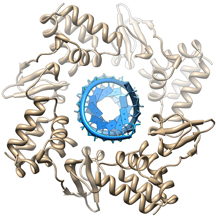Researchers Reveal How Deadly Virus Silences Immune System
Scientists at The Scripps Research Institute have determined the structure of a critical protein from the Marburg virus, a close cousin of Ebola virus. These viruses cause similar diseases and are some of the deadliest pathogens on the planet, each killing up to 90 percent of those infected.
Described in the September 13, 2012 publication of the journal PLoS Pathogens, the new research reveals how a key protein component of the Marburg virus, called VP35, blocks the human immune system, allowing the virus to grow unchecked. The structure provides a major step forward in understanding how the deadly virus works, and may be useful in the development of potential treatments for those infected.
“The immune system is designed to recognize certain hallmarks of virus infection,” said Erica Ollmann Saphire, the Scripps Research scientist who led the effort. “When these are sensed, an immediate antiviral defense is launched. However, the Marburg and Ebola viruses mask the evidence of their own infection. By doing so, the viruses are able to replicate rapidly and overwhelm the patient’s ability to launch an effective defense.”
Deadly Outbreaks
Ebola virus outbreaks have occurred in the last month in both Uganda and the Democratic Republic of the Congo, while Marburg virus broke out in Angola in 2005 to 2006 and again in Uganda in 2007. The Angolan Marburg virus outbreak began in a pediatric ward and killed 88 percent of those it infected. The virus has since been imported into the United States (Colorado) and the Netherlands by tourists who had visited Africa.
There is currently no cure for Marburg hemorrhagic fever. The virus is spread when people come into contact with the bodily fluids of a person or animal who is already infected. The best treatment consists of administering fluids and taking protective measures to ensure containment, like isolating the patient and washing sheets with bleach.
Most people, however, die within two weeks of exposure from a combination of dehydration, massive bleeding, and shock. A smaller number of people have stronger and immediate immune responses against the virus and survive.
A New Roadmap for Defense
The breakthrough described in the PLoS Pathogens article explains a key reason why the viruses are so deadly and provides the necessary templates to develop drugs to treat the infection.
The study’s lead author, Research Associate Shridhar Bale, explains that a key signature of Marburg virus infection is the double-stranded RNA that results from its replication inside cells. When human immune system proteins detect this virus-specific RNA, they sound an alarm to signal the rest of the immune system to respond. The new research describes how the VP35 protein of the Marburg virus binds to the viral double-stranded RNA and hides it to prevent the alarm from being sounded.
The new research also revealed a surprise. Images from the Marburg virus reveal the VP35 protein spirals around the double-stranded RNA, enveloping it completely. This is in contrast to previous images of the similar VP35 protein from Ebola virus that showed it only capping the ends of the RNA, leaving the center of the RNA helix exposed for possible recognition.
In addition to Ollmann Saphire and Bale, the article, “Marburg virus VP35 can both fully coat the backbone and cap the ends of dsRNA for interferon antagonism,” was authored by Jean-Philippe Julien, Zachary A. Bornholdt, Michelle A. Zandonatti, Gerard J.A. Kroon, Christopher R. Kimberlin, Ian J. MacRae, and Ian A. Wilson of The Scripps Research Institute, and Peter Halfmann, John Kunert, and Yoshihiro Kawaoka of the University of Wisconsin. or more information on the study, see http://www.plospathogens.org/article/info%3Adoi%2F10.1371%2Fjournal.ppat.1002916
Support for the research was provided by grants from the Burroughs Wellcome Fund and The Skaggs Institute for Chemical Biology at Scripps Research.
Send comments to: press[at]scripps.edu














